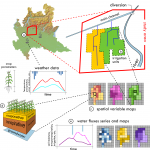
NEED mode is the first simulation option that can be used to estimate the crop water requirements of a study area over a user defined time horizon, accounting for the space variability soil and crop characteristics, for the efficiency of irrigation application at the field scale. If conveyance and distribution network characteristics are provided, the model can estimate the cumulative daily flow diversion requirement from each of the irrigation water sources, accounting for the conveyance and distribution efficiency. The figure shows a schematic of the modelling approach, consisting of the following steps:
- identification of the study area,
- selection of the meteorological stations,
- collection of the meteorological input series of each station over the selected simulation horizon,
- discretization of the area with a regular spatial mesh,
- setting land use and soil hydraulic parameters of each cell,
- setting irrigation method and management criterion for each cell,
- running the simulation of the daily water balance for each cell of the mesh over the simulation horizon.
Optionally the user can provide a list of water sources feeding the study area and eventually a value of the conveyance efficiency from each source to each cell. In this case, daily values of the flowrate of each source that need to be supplied to the study area to satisfy the crop water requirements can be computed by the model. Moreover, according to the characteristics of the conveyance and distribution network, the study area can be split into irrigation units, each receiving water supply through a delivery point of the network. Irrigation units include multiple cells, sharing the same water supply with a unique value of the conveyance efficiency.

